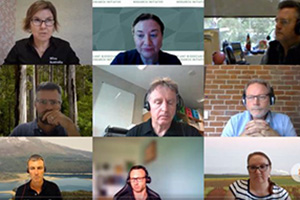The PBRI fora continue to highlight expertise and knowledge which may for the development of future RD&E investments.
The PBRI has prioritised Surveillance RD&E as one of its Key Focus Areas, with interest in investing in activities that aim to enhance surveillance across the country. The aim is to reduce surveillance costs and increase coverage over large and remote areas, with better methods of coordination of data capture.
The last forum of the year, introduced by Dr Satendra Kumar, NSW Chief Plant Protection Officer concentrated on Biosecurity Surveillance RD&E. Satendra described the challenges for the state jurisdictions in maintaining capacity & capability, in applying technology and innovation on the ground and in the ability to provide surveillance activities across the biosecurity continuum.
The first speaker was Dr Tuyet Hoang, Program Manager for Austrakka, the nationally recognised platform for real-time analysis of genomic data for public health. Tuyet presented their high-profile work on national Covid-19 strain tracking, during the pandemic. The potential for a similar plant diagnostics genome tracking system will be considered further by PBRI members.
Dr Ryan Higgs, Onside CEO presented a digital check-in app for farmers, growers, and contractors. The App enables the identification of biosecurity risk on farm through tracing movement. Dr Elizabeth McCrudden, Pacific Engagement and International Plant Health, DAWE, described the successful use of WhatsApp in remote surveillance in PNG, due to Covid travel restrictions. Dr Paul Barber, ArborCarbon Managing Director spoke about improving surveillance activities using airborne remote sensing and AI. Shakira Johnson, Communication and Extension, AUSVEG, provided an overview of the iMapPESTs project and presented industry feedback on the project outcomes.
The audience heard perspectives on Surveillance from industry and government in a panel session at the end of the forum. This included Dr Sharon Harvey, R&D Program Manager, Wine Australia who spoke about the benefits of having access to the Commonwealth’s pest interception data to better inform Wine Australia’s investment in biosecurity research. Bill Gordon, NSW Grains Biosecurity Officer identified the collection, coordination, and management of surveillance data as a big issues. He saw opportunities to improve information sharing and to prioritise targets for surveillance. As part of this, community engagement will be particularly important.
Dr Nicole Thompson, Sugar Research Australia described surveillance activities for the sugar industries as generally occurring in response to an incursion or as small, targeted programs. This presents difficulty in analysing data across multiple small programs. In the sugar industry, machinery movement occurs across the state and between states, so monitoring processes in place are critical.
Francisco (Paco) Tovar, National Forest Biosecurity Coordinator, Plant Health Australia, saw innovative technologies as being expensive to implement and not always designed for operational purposes. Paco suggested there is value in extend existing technologies such as the Austrakka platform, ArborCarbon, AusPest Check, MyPestGuide. These tools are available but better industry involvement in the design and delivery could occur.
Dr Greg Chandler R&D Manager-Biosecurity, Hort Innovation, described remote sensing as a useful tool to cover large spatial scales and in directing ground surveillance to high-risk areas. Data collection for market access should also include data for key exotic species, to increase efficiency. Surveillance R&D investment should consider the longevity of surveillance tools and the business model for future use.
Dr Stephen Dibley, Deputy Chief Plant Health Officer, AgVictoria, explained that state jurisdictions are focused on early detection or delimiting activities in an incursion. He also emphasised that labour resources for surveillance are always limited. Data sharing is occurring between the Commonwealth and jurisdictions which is proving very valuable.
Dr David Teulon, Director, Better Border Biosecurity (B3) New Zealand shared the important aspects of surveillance R&D that he looks for when considering funding. He emphasised that surveillance is key to all parts of the biosecurity continuum. Technology is available but where should it be applied and is it fit for purpose? Can the technology be used now or in five, 10- or 20-years’ time? Climate change will be a layer to consider which may demand iterative changes to the biosecurity system to adapt. New Zealand has a biosecurity team of five million – how do we continue to engage the community on Biosecurity?
Common areas discussed on the cross-industry and government panel will be used to develop future research.
The next forum will be on Biosecurity RD&E in the Pacific on 20 April 2022.
More information contact jo.luck@horticulture.com.au
